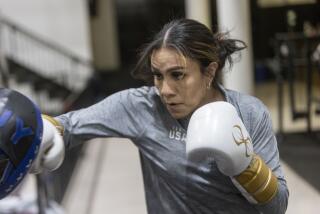The Golden Boy’s journey
- Share via
American Son
My Story
Oscar De La Hoya with Steve Springer
HarperCollins: 286 pp., $25.95
--
FOR decades, the health of boxing depended on the presence of a crossover star -- the pugilist who could compel non-boxing fans to hit the pay-per-view button. In the late ‘80s and ‘90s, Mike Tyson was the magnet, but by the time his antics ended, boxing was badly bloodied and had been shooed off network television. Enter the Golden Boy, Oscar De La Hoya, a virtuoso of violence who had never been in a street fight and looks like a choirboy.
A Mexican American from the south side of middle-class, De La Hoya did more than anyone to keep the sweet science from slipping into the dark ages. In the process, he earned hundreds of millions of dollars. The East L.A. native is also the first fighter to succeed on the Don King side of the sport. In only a few years, his Golden Boy Promotions Inc. has become a dominant force in the boxing business. As if that weren’t enough, his Latin pop CD, released in 2000, was nominated for a Grammy.
With the adept aid of Times sportswriter and boxing scribe Steve Springer, De La Hoya recounts his rise from ragtag local gym rat to the Tiger Woods of boxing. Like many people in the game that is no game, De La Hoya is the progeny of generations of fighters. Among such folks, pickup boxing is as common as pickup basketball. At 4, he was prodded into a sparring session with a cousin at his Uncle Lalo’s house. The future prince of pugilism got whacked and quit in tears. A year later, however, he was shadowing his older brother to a local gym, and the train of his future started to roll.
Self-restriction is at the root of great art, and soon the young De La Hoya showed a monk’s devotion to his martial art. He was a natural lefty, but a coach converted him to an orthodox style. He thus led with his power hand, and developed a left hook that turned out the lights for scores of opponents.
By 14, De La Hoya was a local boxing star and had begun sparring with pros. Tall and lean, he fought as often as twice a week, compiling a mind-boggling amateur record of 223 wins and 5 losses. The entire family was determined that he win an Olympic gold medal. His mother, Cecilia, a fervent supporter of his efforts, succumbed to breast cancer at 39, two years before the 1992 Olympics, but had made it known that she wanted her boy to win the gold in Barcelona. And win it he did. “American Son” describes the swirl of money and offers that followed. It also captures the challenges De La Hoya faced in integrating his identity as an American with his intimate links to Mexico.
Although fight fans will want more, “American Son” brings us inside the ropes of some of the future Hall of Famer’s most famous bouts. For instance, in his May 2007 fight with Floyd Mayweather, which attracted a record-breaking 2.4 million pay-per-view buys, De La Hoya was winning with his jab. But an old injury in his left shoulder flared up, and the six-time world champion resolved to let Mayweather hit him with his right, in the hopes that Floyd would bust his brittle right hand. De La Hoya lost a split decision.
To hear him tell it, De La Hoya’s life has been largely forged by the need for love, as the result of his mother’s early death and his father’s emotional reticence. Some may find it strange for a fighter to chatter about his hours on the couch; here, De La Hoya opens up about the time he spent in therapy shadow-boxing with his complex feelings about his father. He was, he insists, so hurt by his father’s distance that he had three children out of wedlock just so he could shower them with the paternal love denied him. No doubt De La Hoya’s desire to please his father spurred his fierce determination to succeed in boxing. The same filial emotions are likely behind his inability to confront a series of trainer/father figures whose summary dismissals he’d often leave to someone else.
“American Son” does not conceal De La Hoya’s darker side. For a time, he had a gambling problem and once lost $350,000 in a single night. He went through women like a poker player pushing chips. From the outset, he was the axis of a galaxy of people; not surprisingly, as a young celebrity he tended to see himself as the center of the world. Today, however, he’s married and an active participant in social causes, including building schools in East L.A. and helping to provide medical services there. At 35, and in the last round of his life as an athlete, he remains a work in progress. This memoir, his first literary glance in the rearview mirror, is a revealing and solid read.
--
A former boxer and an active trainer, Gordon Marino is a professor of philosophy at St. Olaf College in Minnesota.
More to Read
Go beyond the scoreboard
Get the latest on L.A.'s teams in the daily Sports Report newsletter.
You may occasionally receive promotional content from the Los Angeles Times.










